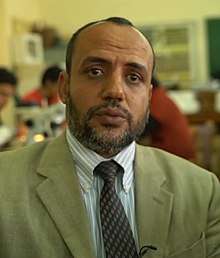Hesham Sallam
Hesham Sallam is an Egyptian Associate Professor at School of Sciences and Engineering, American University in Cairo and Department of Geology, Mansoura University, Egypt and the founder of Mansoura University Vertebrate Paleontology Center. In January 2018, Sallam and his team discovered Mansourasaurus in Mansoura, Egypt.[2] He received his bachelor degree (1997) from the Department of Geology at Mansoura University in Egypt then he completed his Ph.D. in 2010 at the University of Oxford (UK). In addition, he was a visiting scholar at Stony Brook University, Ohio University, Denver Museum of Nature & Science and Duke University, USA for a year (2014/2017). Over the course of last 10 years, he has been conducting paleontological research on the vertebrate fossils of Afro-Arabia. The work resulted in a series of publications in high profile journals such as Proceedings of the National Academy of Sciences (PNAS), Nature Ecology & Evolution, Nature Communications, PLoS ONE, PeerJ, Journal of Vertebrate Paleontology, and Palaeontology.
Hesham Sallam | |
|---|---|
 | |
| Nationality | Egyptian |
| Education | Mansoura University, Oxford University |
| Known for | Mansourasaurus |
| Scientific career | |
| Fields | Vertebrate Paleontology |
| Institutions | American University in Cairo Mansoura University[1] |
| Theses | |
| Doctoral advisor | Erik Seiffert; Stephen Hesselbo |
His important contribution to Egyptian paleontology is that he founded the Mansoura University Vertebrate Paleontology (MUVP), the only high-level vertebrate paleontology research unit in the Middle East, a combined research, outreach, and conservation endeavor based out of Mansoura University, Egypt. MUVP’s most significant accomplishment was the discovery, recovery, and description of the large sauropod dinosaur Mansourasaurus, which was found in the Dakhla Oasis area of Egypt. This new species revealed previously unappreciated biotic links between the Afro-Arabian and Eurasian landmasses during the close of the Cretaceous period, around 73 million years ago.
Discovering Mansourasaurus
Hesham Sallam, together with a team of students discovered a sauropod skeleton in the Dakhla Oasis in Egypt's Western Desert.[3] In 2016, it was reported that over thirty dinosaur specimens had been excavated, among them titanosaurian sauropods.[4]
Based on this skeleton, the type species Mansourasaurus shahinae was named and described in January 2018, by Hesham M. Sallam, Eric Gorscak, Patrick M. O'Connor, Iman A. El-Dawoudi, Sanaa El-Sayed, Sara Saber, Mahmoud A. Kora, Joseph J. W. Sertich, Erik R. Seiffert and Matthew C. Lamanna. The generic name refers to the Mansoura University. The specific name honours Mona Shahin, one of the founders of the Mansoura University Vertebrate Paleontology Center.[5]
The Mansourasaurus specimen described in 2018 is its holotype, MUVP 200, discovered in a layer of the Quseir Formation dating from the late Campanian, about seventy-three million years old. It consists of a partial skeleton with skull and lower jaws.[5] It contains a fragment of the skull roof, a part of the lower braincase, the dentaries of the lower jaws, three neck vertebrae, two back vertebrae, eight ribs, the right scapula, the right coracoid, both humeri, a radius, a third metacarpal, three metatarsals, and parts of osteoderms. The skeleton was found on a surface of four by three metres. It was not articulated. The authors concluded that the holotype is a juvenile specimen, because the bones of its shoulder girdle had not yet fused. An ulna, specimen MUVP 201, found at twenty metres distance from the skeleton, was not referred to the species as it seemed somewhat too large for the holotype individual and a general connection to the species could not be proven.[5]
References
- Hesham Sallam's CV
- Nature
- Kaplan, Karen (2018-01-29). "Why this dinosaur from Egypt is a big deal in more ways than one". Los Angeles Times. Retrieved 2018-01-30.
- Iman El-Dawoudi, Patrick M O'Connor, Mahmoud Kora and Joseph J W Sertich, 2016, "NEW DINOSAUR REMAINS FROM THE CAMPANIAN QUSEIR FORMATION, WESTERN DESERT, EGYPT", SVP October 2016, Program and Abstracts, p 129
- Sallam, H.; Gorscak, E.; O'Connor, P.; El-Dawoudi, I.; El-Sayed, S.; Saber, S. (2017-06-26). "New Egyptian sauropod reveals Late Cretaceous dinosaur dispersal between Europe and Africa". Nature. 2 (3): 445–451. doi:10.1038/s41559-017-0455-5. PMID 29379183.